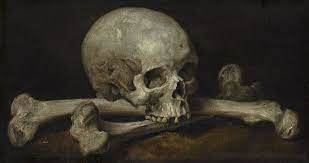Ash Wednesday
Feb. 22nd, 2023 05:55 pm
Memento, homo, quia pulvis es, et in pulveram reverteris.
Ash Wednesday
As all things come round again, we have come once again to the time of Lent.
A reflection for Ash Wednesday.
As we saw at Christmas, Adam and Eve are, in a sense, a single person, Adam-Eve. Adam represents the higher part of the soul, the nous; Eve, born from his chest, represents the middle and lower parts of the soul. Turning toward material creation in obedience to Desire, the Serpent, the Human Adam-Eve sins. Turning away from the Eternal, the Human Being is trapped in matter, doomed to struggle perpetually with Desire, to die and return to dust, and return to life again.
Repenting, purifying, turning again toward Eternal things over the long course of the Earthly sojourn, the Human Being is born now as Mary, sinless (Immaculate) and unencumbered by desire (Virgin). As Adam brought forth Eve from his chest, so Mary brings forth Christ from her womb, signifying that the soul is now purified unto its lowest parts, and now turns only toward eternal things. Before the nous was masculine, which is to say, active; now the nous becomes female, receptive to the will of God. The Desire, signified in the body by the lower dantien, is altogether purified and turned toward the higher.
Now, at the beginning of Lent, the adult Christ is the New Adam, the restored humanity, beginning the process by which the chains of matter will be overcome, and mankind restored to the Eternal.
Ashes, Again
In the ritual of Ash Wednesday, consecrated ashes are placed over the Third Eye of the initiate. This is done on a day of fasting and abstinence, which begins a season of fasting, repentance, and atonement for sin. The activation of the third eye, the abstinence from flesh and from wine all serve to withdraw the initiate from the material. To repent (metanoia) is to purify the nous and unite the inner will with the Eternal Will of God. To atone for sin means to gather the dis-united parts of the self and bring the whole soul under the command of the nous, itself aware of and united to the Will of God.
The initiate, addressed as homo, "human," is reminded that he is dust. What is dust? The human, and everything pertaining to it. The body and the possessions. But also the desires, the habits, the preferences, the thoughts-- all are dust. Only the divine is immortal, and only that within us which participate in the divine can be immortal. Everything else is dust and ashes. The old human was Adam, who died, and descended into the Earth, which is to say, into the material body. The new human is Christ, who will die and be reborn, overcoming death by death. We have all been Adam and Eve. In the Mysteries of Christmas we become Mary, and bring forth the Christ-Child. Now we must become Christ, and follow Him on the road to Calvary. It is not an easy road, but at the end of it is the resurrection, and life eternal.
The ashes, placed on the forehead, are made from the burned fronds of last year's palms. The palms, we recall, were laid at the feet of Christ, will be laid at the feet of Christ, as he enters into Jerusalem. Alive then, they are now ashes, and this year there will be new palms, and next year, new ashes. Thus the cycle continues. As the palms are burned year after year, so many will strive this year, which is to say, this lifetime, and fall short. They will burn, and then they will try again, and again, and again, unto the ending of the age. Until all are saved from the fire.